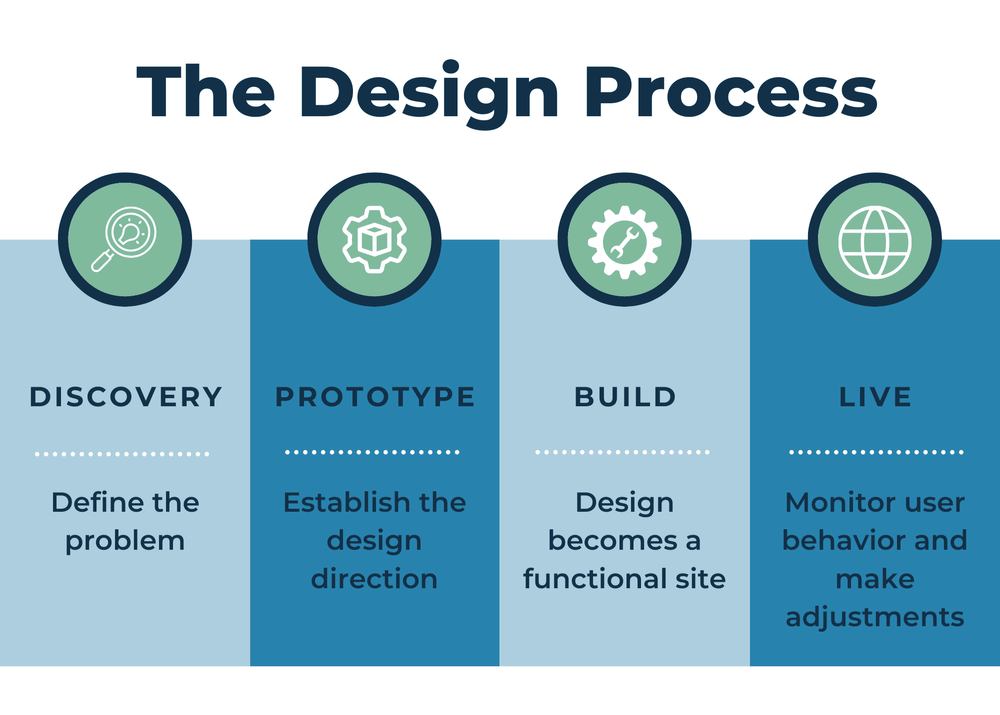The 4 Phase Process Description

Introduction
Argosy’s goal is to help new businesses grow and thrive. We realize that not everyone can afford a top of the line website at the outset, and so our process focuses on breaking down a project into smaller “chunks” that can be achieved over time. The client can add functionality as slowly as they can afford. We want to continue our agency-client relationship long after the project launches, because our clients’ success leads to our success. We call this “getting you on the roadmap.”
Our design process is based on established digital marketing and UX best practices but might look a little different than what you’re used to. Instead of making a “best guess” on how long and how much money it’ll take to complete in its entirety, we break any project into 4 phases: 1) Discovery, 2) Prototyping, 3) Build, and 4) Live.
Each of these phases are considered to be standalone projects, each with their own proposals, requirements, costs, and timelines. A key component of this design process is that each phase defines the next. For example, in the discovery phase, the goal is to learn enough about what’s needed to get us to the prototyping phase. This reduces risk for the client, allows us to make better cost estimates, and reduces failure, because each phase is fully researched and discussed.
Discovery Phase
The discovery phase is a period of time dedicated to defining the problem being solved and project’s scope. This typically includes a project kickoff, identifying constraints, reviewing similar websites, defining client roles, and establishing key performance indicators that will let us know that the website has been successful.
Project Kickoff
This is a meeting dedicated to getting to know each other. The agency gets a sense of what the client is looking for and whether we can offer a solution to the problem.
Define Stakeholder Roles
Defining stakeholder roles allows us to have more productive discussions.
Empathy Maps
An empathy map is a collaborative tool that teams can use to better understand their customers. Argosy will create one based on discussions with the client about the target audience[1].
Key Performance Indicators
Key performance indicators (KPIs) allow us to know whether the website build was a success. Argosy will work with the client to create these based on their business goals [2].
Establish Shared Design Principles
Design principles are a set of short statements that define how you’re going to go about making decisions regarding design during the process. For example, “we make it accessible for all.” Design principles help move the process away from people’s personal opinions and more toward a framework of making decisions [3].
Deliverables, Timeline, and Cost
Timeline: Depending on project size, this can range from a few days to multiple weeks.
Deliverable: A document that defines all of the information and user research needed to kickoff the prototyping phase. It’ll include a feature list, potential pages, forms, etc.
Cost: This phase accounts for roughly 10% of the overall project cost. For example, in a project estimated to cost roughly $3,500, expect to pay $350.
Prototyping Phase
In this phase, the design direction is established and the scope of the build is defined. This is where the bulk of the design happens.
Argosy will:
- Establish aesthetics (color palette, format logo, branding)
- Create navigable mockups or wireframes with draft content for each page
- Initial usability and aesthetic testing
Deliverables, Timeline, and Cost
The timeline and cost for this is highly dependent on the results of the Discovery phase.
Timeline: This can range from a few weeks to more than a month.
Deliverable: Navigable mockups of each page, and established aesthetics
Cost: You can expect it to be roughly 40% of the total estimated project cost.
Build Phase
The build stage is where the designs from the Prototyping phase are turned into fully functional websites. It is when the design is finalized to be fully responsive and include states for things like buttons and forms.
It includes a responsive website (works on desktop and mobile), functional buttons, defined forms, error messaging content, usability testing, etc.
Deliverables, Timeline, and Cost
Again, the timeline and cost for this is highly dependent on the results of the Prototyping phase.
Timeline: This can range from a few weeks to months, depending on the rate of communication and the complexity of the design.
Deliverable: A live and functional website and training materials on how to use it.
Cost: You can expect it to be roughly 45% of the total estimated project cost.
Live Phase
Going live should not be the end of the project. Once the website has been launched, it is necessary to monitor user behavior and adjust the design to maximize conversion and engagement. We’ll also look for site errors and release bug fixes as needed. It’s essential to capture bugs soon after the site is released so they don’t become more expensive down the line.
Until a website goes live we only have theoretical knowledge of how the users will respond. The live phase allows us the chance to observe user behavior and make sure the design is working well. We do this by using some combination of:
- analytics
- screen-recording
- heat maps/a-b testing
- usability testing
Deliverables, Timeline, and Cost
Timeline: This could range from a week to a permanent maintenance plan, depending on the client’s needs.
Deliverable: Report on usability issues found post-deployment, immediate critical bug fixes, adjustments to design based on user feedback.
Cost: This is highly dependent on project complexity, but expect 5-10% of total project cost, depending on the scope.
Summary
This document details the Argosy design process and provides rough timelines and cost estimates. By breaking any project down into four phases, we allow for smaller deliverables, more accurate estimates, and less risk for the client.